OCZ Vertex 3 Pro Preview: The First SF-2500 SSD
by Anand Lal Shimpi on February 17, 2011 3:01 AM ESTAnandTech Storage Bench 2011: Much Heavier
I didn't expect to have to debut this so soon, but I've been working on updated benchmarks for 2011. Last year we introduced our AnandTech Storage Bench, a suite of benchmarks that took traces of real OS/application usage and played them back in a repeatable manner. I assembled the traces myself out of frustration with the majority of what we have today in terms of SSD benchmarks.
Although the AnandTech Storage Bench tests did a good job of characterizing SSD performance, they weren't stressful enough. All of the tests performed less than 10GB of reads/writes and typically involved only 4GB of writes specifically. That's not even enough exceed the spare area on most SSDs. Most canned SSD benchmarks don't even come close to writing a single gigabyte of data, but that doesn't mean that simply writing 4GB is acceptable.
Originally I kept the benchmarks short enough that they wouldn't be a burden to run (~30 minutes) but long enough that they were representative of what a power user might do with their system.
Not too long ago I tweeted that I had created what I referred to as the Mother of All SSD Benchmarks (MOASB). Rather than only writing 4GB of data to the drive, this benchmark writes 106.32GB. It's the load you'd put on a drive after nearly two weeks of constant usage. And it takes a *long* time to run.
I'll be sharing the full details of the benchmark in some upcoming SSD articles (again, I wasn't expecting to have to introduce this today so I'm a bit ill prepared) but here are some details:
1) The MOASB, officially called AnandTech Storage Bench 2011 - Heavy Workload, mainly focuses on the times when your I/O activity is the highest. There is a lot of downloading and application installing that happens during the course of this test. My thinking was that it's during application installs, file copies, downloading and multitasking with all of this that you can really notice performance differences between drives.
2) I tried to cover as many bases as possible with the software I incorporated into this test. There's a lot of photo editing in Photoshop, HTML editing in Dreamweaver, web browsing, game playing/level loading (Starcraft II & WoW are both a part of the test) as well as general use stuff (application installing, virus scanning). I included a large amount of email downloading, document creation and editing as well. To top it all off I even use Visual Studio 2008 to build Chromium during the test.
Many of you have asked for a better way to really characterize performance. Simply looking at IOPS doesn't really say much. As a result I'm going to be presenting Storage Bench 2011 data in a slightly different way. We'll have performance represented as Average MB/s, with higher numbers being better. At the same time I'll be reporting how long the SSD was busy while running this test. These disk busy graphs will show you exactly how much time was shaved off by using a faster drive vs. a slower one during the course of this test. Finally, I will also break out performance into reads, writes and combined. The reason I do this is to help balance out the fact that this test is unusually write intensive, which can often hide the benefits of a drive with good read performance.
There's also a new light workload for 2011. This is a far more reasonable, typical every day use case benchmark. Lots of web browsing, photo editing (but with a greater focus on photo consumption), video playback as well as some application installs and gaming. This test isn't nearly as write intensive as the MOASB but it's still multiple times more write intensive than what we were running last year.
As always I don't believe that these two benchmarks alone are enough to characterize the performance of a drive, but hopefully along with the rest of our tests they will help provide a better idea.
The testbed for Storage Bench 2011 has changed as well. We're now using a Sandy Bridge platform with full 6Gbps support for these tests. All of the older tests are still run on our X58 platform.
AnandTech Storage Bench 2011 - Heavy Workload
We'll start out by looking at average data rate throughout our new heavy workload test:
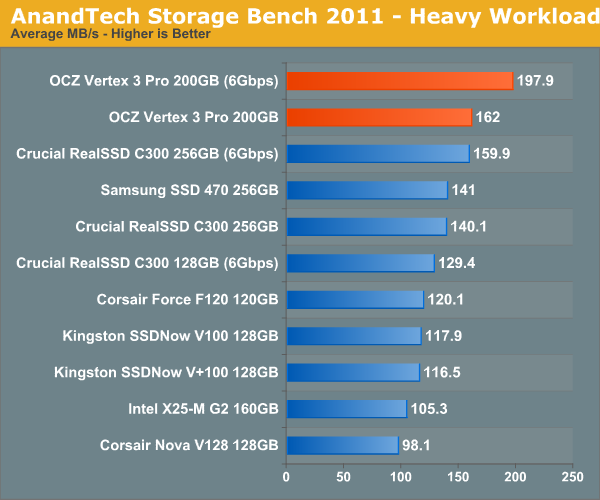
The Vertex 3 Pro on a 6Gbps interface is around 24% faster than Crucial's RealSSD C300. Note that the old SF-1200 (Corsair Force F120) can only deliver 60% of the speed of the new SF-2500. Over a 3Gbps interface the Vertex 3 Pro is quick, but only 15% faster than the next fastest 3Gbps drive. In order to get the most out of the SF-2500 you need a 6Gbps interface.
If we break out our performance results into average read and write speed we get a better idea for the Vertex 3 Pro's strengths:
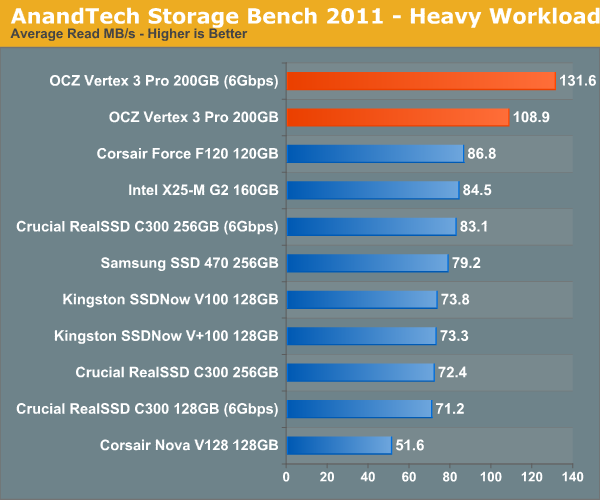
The SF-2500 is significantly faster than its predecessor and all other drives in terms of read performance. Good read speed is important as it influences application launch time as well as overall system responsiveness.
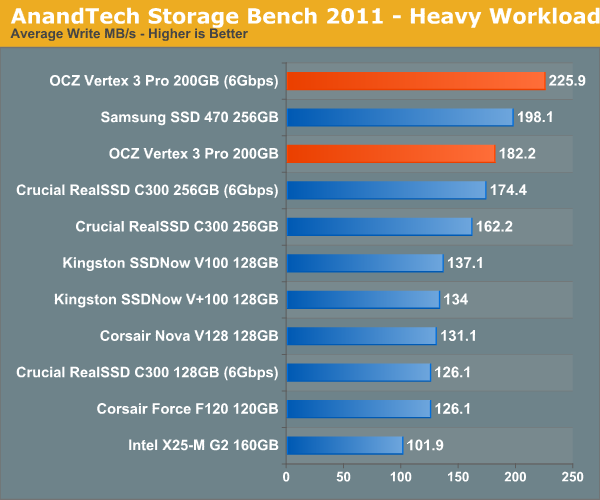
Average write speed is still class leading, but this benchmark uses a lot of incompressible data - you'll note that the Vertex 3 Pro only averages 225.9MB/s - barely over its worst case write speed. It's in this test that I'm expecting the new C400 to do better than SandForce.
The next three charts just represent the same data, but in a different manner. Instead of looking at average data rate, we're looking at how long the disk was busy for during this entire test. Note that disk busy time excludes any and all idles, this is just how long the SSD was busy doing something:
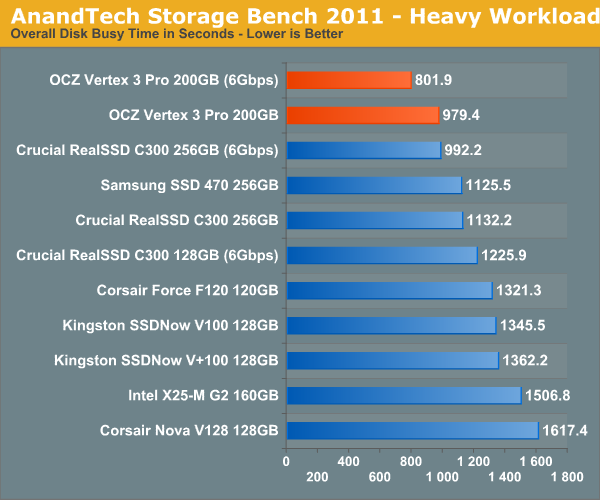
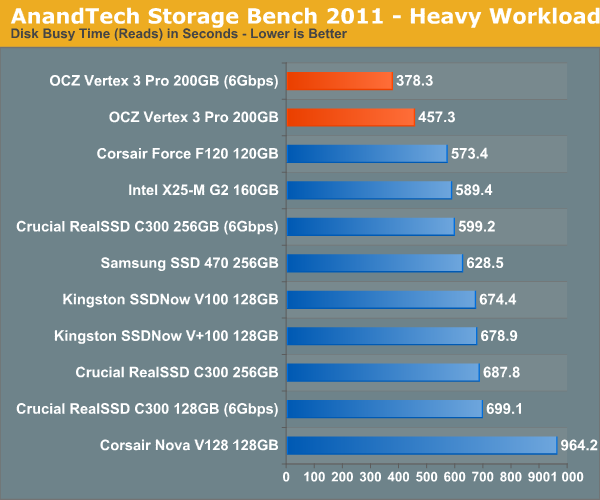


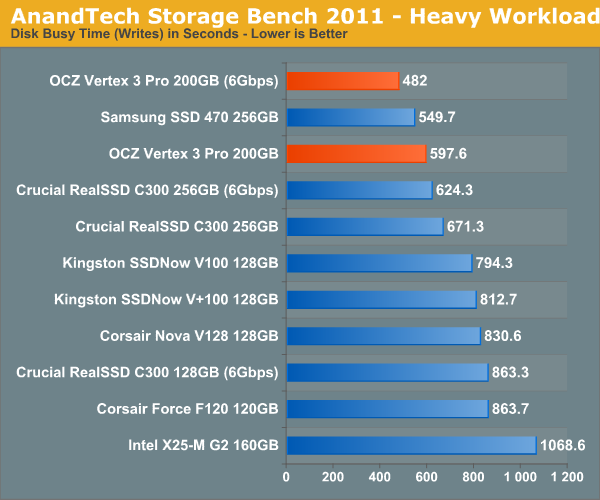








144 Comments
View All Comments
Chloiber - Thursday, February 17, 2011 - link
It's correct, Anand answered the exact same question already on page 1/2 of the comments.7Enigma - Thursday, February 17, 2011 - link
Yup, saw that on my second read through. A little clarification in the article would have made it a bit more explainable but at least the numbers are right.teldar - Thursday, February 17, 2011 - link
Hope this gets seen.I used to go to a site frequently for info on drive reliability.
storagereview.com
I don't believe its really being updated anymore. I would love to side you be able to integrate a site like theirs (or theirs completely) into here.
argosreality - Thursday, February 17, 2011 - link
They've been updating the site for the last six months or so with new reviews. Actually, they just reviewed the new Vertex2 drives with 25nm flashtomoyo - Friday, February 18, 2011 - link
Ya storagereview is quite alive now. They were dead for over a year, but I'm glad to have another good source of hdd/ssd info again.KenPC - Thursday, February 17, 2011 - link
OCZ needs a distraction - NOWSo serve up a prototype (even without a case yet) drive and get fabulous bench results and lots of press to drown out the behind the scenes downgrading of many of the on-market products.
Yes, this new controller/architecture for this particular prototype is faster. Yes, it appears to be very promising technology in the SSD space.
But now folks will be using THIS prototype review to measure the purchase decisions for drives sold months from now that may/may not have the same performance
MeSh1 - Thursday, February 17, 2011 - link
Wow, thats some tasty hardware :). 400GB @ $1350. The Revo X22 480GB is just under that, hmm..... decisions. Revo Drive uses SF1200 I wonder if they can slap a SF200 on the Revo :)Breit - Friday, February 18, 2011 - link
you can bet on that. ocz will definitely roll out a new revodrive with sf2000 on it when the time comes, trust me. :)geniekid - Thursday, February 17, 2011 - link
Don't know if anyone from AT will get this far in the comments, but...1) I like how the beginning of the article rehashes how SSDs work instead of linking back to earlier articles. The redundancy makes it a lot easier to read the article.
2) I think the real world usage of these things is invaluable. Theoretical limits almost never ever mirror real world usage. *Thumbs up*
TrackSmart - Friday, February 18, 2011 - link
I agree completely on the REAL WORLD tests. Looking at the PCMark Vantage scores, it's clear that the incredible speeds of the Vertex 3 will only yield marginal gains in *total system performance* compared to the current crop of SSDs (Agility 2, Vertex 2, etc). Hopefully the price of the new drives will be similar to the old ones. Or lower, forcing even more affordable pricing on the existing, fast-enough models.